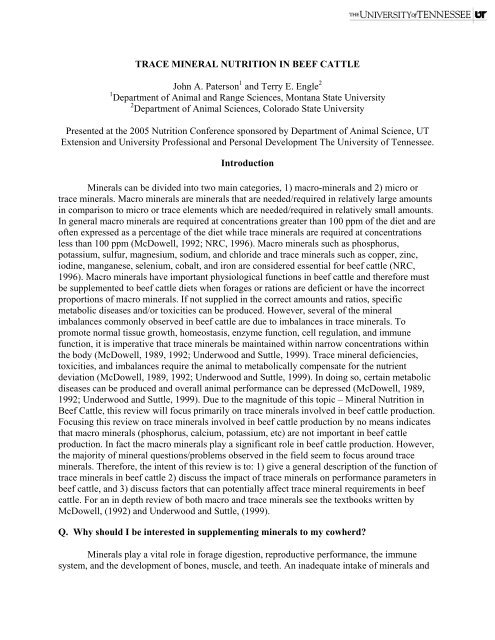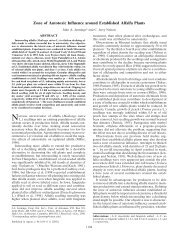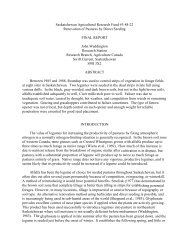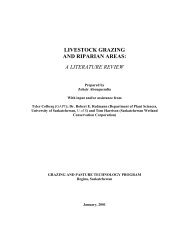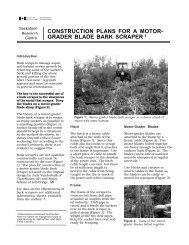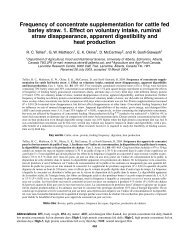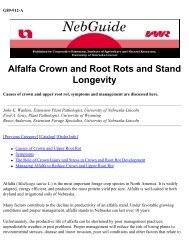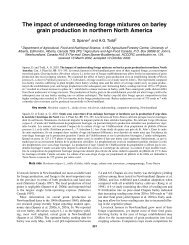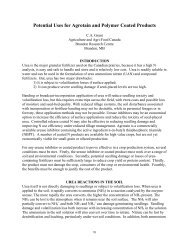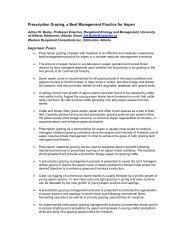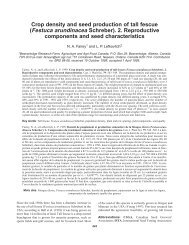Trace Mineral Nutrition in Beef Cattle
Trace Mineral Nutrition in Beef Cattle
Trace Mineral Nutrition in Beef Cattle
You also want an ePaper? Increase the reach of your titles
YUMPU automatically turns print PDFs into web optimized ePapers that Google loves.
TRACE MINERAL NUTRITION IN BEEF CATTLEJohn A. Paterson 1 and Terry E. Engle 21 Department of Animal and Range Sciences, Montana State University2 Department of Animal Sciences, Colorado State UniversityPresented at the 2005 <strong>Nutrition</strong> Conference sponsored by Department of Animal Science, UTExtension and University Professional and Personal Development The University of Tennessee.Introduction<strong>M<strong>in</strong>eral</strong>s can be divided <strong>in</strong>to two ma<strong>in</strong> categories, 1) macro-m<strong>in</strong>erals and 2) micro ortrace m<strong>in</strong>erals. Macro m<strong>in</strong>erals are m<strong>in</strong>erals that are needed/required <strong>in</strong> relatively large amounts<strong>in</strong> comparison to micro or trace elements which are needed/required <strong>in</strong> relatively small amounts.In general macro m<strong>in</strong>erals are required at concentrations greater than 100 ppm of the diet and areoften expressed as a percentage of the diet while trace m<strong>in</strong>erals are required at concentrationsless than 100 ppm (McDowell, 1992; NRC, 1996). Macro m<strong>in</strong>erals such as phosphorus,potassium, sulfur, magnesium, sodium, and chloride and trace m<strong>in</strong>erals such as copper, z<strong>in</strong>c,iod<strong>in</strong>e, manganese, selenium, cobalt, and iron are considered essential for beef cattle (NRC,1996). Macro m<strong>in</strong>erals have important physiological functions <strong>in</strong> beef cattle and therefore mustbe supplemented to beef cattle diets when forages or rations are deficient or have the <strong>in</strong>correctproportions of macro m<strong>in</strong>erals. If not supplied <strong>in</strong> the correct amounts and ratios, specificmetabolic diseases and/or toxicities can be produced. However, several of the m<strong>in</strong>eralimbalances commonly observed <strong>in</strong> beef cattle are due to imbalances <strong>in</strong> trace m<strong>in</strong>erals. Topromote normal tissue growth, homeostasis, enzyme function, cell regulation, and immunefunction, it is imperative that trace m<strong>in</strong>erals be ma<strong>in</strong>ta<strong>in</strong>ed with<strong>in</strong> narrow concentrations with<strong>in</strong>the body (McDowell, 1989, 1992; Underwood and Suttle, 1999). <strong>Trace</strong> m<strong>in</strong>eral deficiencies,toxicities, and imbalances require the animal to metabolically compensate for the nutrientdeviation (McDowell, 1989, 1992; Underwood and Suttle, 1999). In do<strong>in</strong>g so, certa<strong>in</strong> metabolicdiseases can be produced and overall animal performance can be depressed (McDowell, 1989,1992; Underwood and Suttle, 1999). Due to the magnitude of this topic – <strong>M<strong>in</strong>eral</strong> <strong>Nutrition</strong> <strong>in</strong><strong>Beef</strong> <strong>Cattle</strong>, this review will focus primarily on trace m<strong>in</strong>erals <strong>in</strong>volved <strong>in</strong> beef cattle production.Focus<strong>in</strong>g this review on trace m<strong>in</strong>erals <strong>in</strong>volved <strong>in</strong> beef cattle production by no means <strong>in</strong>dicatesthat macro m<strong>in</strong>erals (phosphorus, calcium, potassium, etc) are not important <strong>in</strong> beef cattleproduction. In fact the macro m<strong>in</strong>erals play a significant role <strong>in</strong> beef cattle production. However,the majority of m<strong>in</strong>eral questions/problems observed <strong>in</strong> the field seem to focus around tracem<strong>in</strong>erals. Therefore, the <strong>in</strong>tent of this review is to: 1) give a general description of the function oftrace m<strong>in</strong>erals <strong>in</strong> beef cattle 2) discuss the impact of trace m<strong>in</strong>erals on performance parameters <strong>in</strong>beef cattle, and 3) discuss factors that can potentially affect trace m<strong>in</strong>eral requirements <strong>in</strong> beefcattle. For an <strong>in</strong> depth review of both macro and trace m<strong>in</strong>erals see the textbooks written byMcDowell, (1992) and Underwood and Suttle, (1999).Q. Why should I be <strong>in</strong>terested <strong>in</strong> supplement<strong>in</strong>g m<strong>in</strong>erals to my cowherd?<strong>M<strong>in</strong>eral</strong>s play a vital role <strong>in</strong> forage digestion, reproductive performance, the immunesystem, and the development of bones, muscle, and teeth. An <strong>in</strong>adequate <strong>in</strong>take of m<strong>in</strong>erals and
vitam<strong>in</strong>s may result <strong>in</strong> 1) reduced forage <strong>in</strong>take; 2) lower reproductive efficiency; 3) poor diseaseimmunity; 4) slower daily ga<strong>in</strong>s, and 5) poorer feed conversion. Sub cl<strong>in</strong>ical trace m<strong>in</strong>eraldeficiencies occur more frequently than recognized by most livestock producers. This may be alarger problem than an acute m<strong>in</strong>eral deficiency, because the rancher does not see specificsymptoms that are characteristic of a trace m<strong>in</strong>eral deficiency. With a sub cl<strong>in</strong>ical deficiency, theanimal grows or reproduces at a reduced rate, uses feed less efficiently and operates with adepressed immune system (McDowell, 1989, 1992; Underwood and Suttle, 1999). Texas A&Mresearchers believe trace element deficiencies may impact production <strong>in</strong> better-managed herdseven more than previously recognized. Table 1 shows the six macro-m<strong>in</strong>erals and seven tracem<strong>in</strong>erals that cattle require.Macro <strong>M<strong>in</strong>eral</strong>sCalciumPhosphorusMagnesiumSaltPotassiumSulfurTable 1. <strong>M<strong>in</strong>eral</strong>s <strong>Cattle</strong> Need<strong>Trace</strong> <strong>M<strong>in</strong>eral</strong>sCopperQ: Why should I be concerned about trace m<strong>in</strong>erals for my cow herd?Supplement<strong>in</strong>g m<strong>in</strong>erals to beef cattle has been shown to have positive effects onreproduction, immune status, disease resistance and feed <strong>in</strong>take. <strong>Trace</strong> m<strong>in</strong>erals are needed forvitam<strong>in</strong> synthesis, hormone production, enzyme activity, collagen formation, tissue synthesis,oxygen transport, energy production, and other physiological processes related to growth,reproduction and health. The requirement for trace m<strong>in</strong>erals is often based upon the ability of theanimal to ma<strong>in</strong>ta<strong>in</strong> a desired level of performance. Table 2 shows the trace m<strong>in</strong>eral requirementsfor grow<strong>in</strong>g and f<strong>in</strong>ish<strong>in</strong>g cattle, and cows.Z<strong>in</strong>cManganeseCobaltIod<strong>in</strong>eIronSelenium
Table 2. <strong>Trace</strong> m<strong>in</strong>eral requirements for beef cattlemg of m<strong>in</strong>eral required per kg of dry matter consumed<strong>M<strong>in</strong>eral</strong> Grow<strong>in</strong>g-F<strong>in</strong>ish<strong>in</strong>g Cows<strong>Cattle</strong>Cobalt 0.1 0.1Copper 10 10Iod<strong>in</strong>e 0.5 0.5Iron 50 50Manganese 20 30Selenium 0.1 0.1Z<strong>in</strong>c 30 30How did we discover that trace m<strong>in</strong>erals were necessary for livestock?Copper, molybdenum and sulfur:Z<strong>in</strong>c:• The necessity of copper for cattle was first established <strong>in</strong> the 1930's with the discovery <strong>in</strong>Florida that cattle that had a wast<strong>in</strong>g disease were deficient <strong>in</strong> cobalt, iron, and copper.Researchers <strong>in</strong> Northern Europe described this wast<strong>in</strong>g disease by animals as hav<strong>in</strong>gdiarrhea, loss of appetite, and anemia (McDowell,1992).• In the late 1930's, scientists <strong>in</strong> England described a severe scour<strong>in</strong>g disease of cattlecalled "teart" that was caused by <strong>in</strong>gestion of forage with high levels of molybdenum(McDowell,1992). Later scientists discovered that large doses of copper sulfate couldprevent this condition. Still later it was shown that molybdenum limited the retention ofcopper <strong>in</strong> the body, especially <strong>in</strong> the presence of adequate amounts of <strong>in</strong>organic sulfate <strong>in</strong>the diet (water?; McDowell,1992). It was this discovery that led to numerous studies onthe relationship among copper, molybdenum, and sulfate. We can summarize these<strong>in</strong>terrelationships as:1. Molybdenum <strong>in</strong> the presence of sulfate reduces the deposition of copper <strong>in</strong> organs and<strong>in</strong>creases the excretion of copper <strong>in</strong> the ur<strong>in</strong>e.2. An <strong>in</strong>crease of dietary copper reduces molybdenum deposition <strong>in</strong> the liver.3. When the copper to molybdenum ratio of forages <strong>in</strong> the presence of adequate sulfate wasless than 2.8 to 1, then copper deficiency is evident. A copper to molybdenum ratio of noless than 4:1 has been proposed to ensure that the copper requirement will be met.4. High levels of dietary z<strong>in</strong>c and iron depress copper absorption and tend to <strong>in</strong>crease therequirements. High dietary levels of z<strong>in</strong>c (100 ppm) reduce liver copper storage.5. <strong>Cattle</strong> can die from copper poison<strong>in</strong>g; these animals may experience nausea, vomit<strong>in</strong>g,salivation, abdom<strong>in</strong>al pa<strong>in</strong>, convulsions, paralysis, and death. The usual cause isimproperly formulated supplements or diets.
• Z<strong>in</strong>c is widely distributed through the body, but animals have a limited ability to storez<strong>in</strong>c <strong>in</strong> a form that can be mobilized to prevent a deficiency <strong>in</strong> cattle. The highestconcentrations of z<strong>in</strong>c were found <strong>in</strong> the follow<strong>in</strong>g order: pancreas, liver, pituitary gland,kidney, and adrenal gland (McDowell,1992). Additional reports have shown that thetesticles and accessory sex glands conta<strong>in</strong> high concentrations of z<strong>in</strong>c (McDowell,1992).• It is suspected that z<strong>in</strong>c was applied as an o<strong>in</strong>tment for sk<strong>in</strong> lesions by several cultures,<strong>in</strong>clud<strong>in</strong>g the Egyptians.• In 1960 scientists discovered that a sk<strong>in</strong> disorder of cattle could be cured with z<strong>in</strong>ctherapy.• Loss of appetite is one of the first signs of deficiency <strong>in</strong> calves, a bow<strong>in</strong>g of the h<strong>in</strong>d legsand stiffness of the jo<strong>in</strong>ts was noted.• In laboratory animals, severe z<strong>in</strong>c deficiency has resulted <strong>in</strong> offspr<strong>in</strong>g with impairedlearn<strong>in</strong>g ability.• Additional cl<strong>in</strong>ical signs of a z<strong>in</strong>c deficiency <strong>in</strong> cattle <strong>in</strong>clude: <strong>in</strong>flammation of the noseand mouth with submucous hemorrhages, unthrifty appearance, rough hair coats, stiffnessof the jo<strong>in</strong>ts with swell<strong>in</strong>g of the feet and fetlocks, cracks <strong>in</strong> sk<strong>in</strong> of coronary bandsaround the hooves, and dry scaly sk<strong>in</strong> on the ears (McDowell,1992).• In graz<strong>in</strong>g animals, a marg<strong>in</strong>al z<strong>in</strong>c deficiency results <strong>in</strong> subnormal growth, fertility, lowserum z<strong>in</strong>c values, and decreased resistance to <strong>in</strong>fection and stress (McDowell,1992)..Selenium:• Dur<strong>in</strong>g the 1930's selenium was identified as the toxic element <strong>in</strong> some forages thatcaused animals to lose hair, nails, and hooves. Selenium is now known to be required byfood animals and humans. Consumption of feedstuffs conta<strong>in</strong><strong>in</strong>g both toxic and deficientconcentrations of selenium present a problem for graz<strong>in</strong>g livestock (McDowell,1992).• Marco Polo <strong>in</strong> his travels <strong>in</strong> western Ch<strong>in</strong>a (ca. 1295) described a syndrome result<strong>in</strong>gfrom the <strong>in</strong>gestion of seleniferous plants. He reported that when horses ate this poisonousplant, hooves dropped off (McDowell,1992).• In 1860 an army surgeon <strong>in</strong> South Dakota also described a fatal disease <strong>in</strong> horses graz<strong>in</strong>gnear Fort Randall. The horses exhibited extreme tenderness and <strong>in</strong>flammation of the feet,accompanied by loss of hair from the mane and tail.• Some speculate that many horses of the U.S Calvary commanded by General Custerexhibited selenium toxicity dur<strong>in</strong>g the summer of 1876.• Pioneers on the northern Great Pla<strong>in</strong>s <strong>in</strong> the 1890s also described selenium toxicity oftheir livestock. They associated the disease with alkali seeps and waters of high saltcontent. It became known as alkali disease (McDowell,1992).• In the 1950s, selenium was reported to be beneficial for livestock and shown to preventliver necrosis <strong>in</strong> sw<strong>in</strong>e and muscular dystrophy <strong>in</strong> calves (McDowell,1992).• Selenium is closely l<strong>in</strong>ked to vitam<strong>in</strong> E; both protect biological membranes fromdegeneration. Lack of these nutrients results <strong>in</strong> tissue breakdown.• Selenium deficiency <strong>in</strong> rum<strong>in</strong>ants is called white muscle disease which is a degenerationof striated muscles. Animals with it have generalized weakness, stiffness, and muscledeterioration. Animals have difficulty stand<strong>in</strong>g.
• There are a couple of cl<strong>in</strong>ical patterns. There is a congenital type of muscular dystrophy<strong>in</strong> which calves are stillborn or die with<strong>in</strong> a few days after sudden physical exertion suchas nurs<strong>in</strong>g and/or runn<strong>in</strong>g. It is usually observed <strong>in</strong> calves between 1 – 2 months of age.• Poor reproductive performance also is a symptom of selenium deficiency and <strong>in</strong>cludesreta<strong>in</strong>ed placenta. Work from Ohio showed that the <strong>in</strong>cidence of reta<strong>in</strong>ed placentas wasreduced when cows were <strong>in</strong>jected with a comb<strong>in</strong>ation of selenium and vitam<strong>in</strong> E(McDowell,1992).• Alkali disease generally happens when animals graze forages with selenium <strong>in</strong> the rangeof 5 to 40 ppm. Certa<strong>in</strong> selenium accumulat<strong>in</strong>g plants have between 100 and 9,000 ppmselenium.• Animals suffer<strong>in</strong>g from selenium toxicity have loss of appetite, lack of thrift<strong>in</strong>ess,cirrhosis of the liver, loss of hair, lameness, and elongated hooves (McDowell,1992).Manganese:• Manganese is <strong>in</strong>volved <strong>in</strong> many of the same processes as z<strong>in</strong>c and copper, although theorig<strong>in</strong>al research that identified Mn as an essential trace element was based onmeasurements of reproductive parameters (Orent and McCollum, 1931; Kemmerer et al.,1931). Hidiroglou (1975) reported that Mn uptake was greater <strong>in</strong> the ov<strong>in</strong>e Graafianfollicle and corpus luteum when compared to other reproductive tissues. This authorsuggested that Mn may be essential for normal ovarian function. As Maas (1987)<strong>in</strong>dicated, Mn deficiency has been associated with the anestrus condition <strong>in</strong> cattle.• Manganese has also been identified as an essential component <strong>in</strong> bone and cartilageformation and growth. Leach (1971) noted that Mn is essential <strong>in</strong> the activation ofglycotranferases that are partly responsible for mucopolysaccharide synthesis.Manganese is also <strong>in</strong>volved <strong>in</strong> lipid and carbohydrate metabolism. Therefore, Mndeficiency can potentially lead to a decrease <strong>in</strong> overall animal growth (Prasad, 1984).Cobalt:• Cobalt (Co) was shown to be essential for rum<strong>in</strong>ats <strong>in</strong> 1935 when it was found to correcta disorder characterized by reduced appetite and weight loss (Underwood, 1971). In1948, Co was shown to be an essential component of vitam<strong>in</strong> B 12 (cobalam<strong>in</strong>). Undernormal situations, domestic rum<strong>in</strong>ants are not dependent on a dietary source of vitam<strong>in</strong>B 12 because rum<strong>in</strong>al microorganisms are capable of synthesiz<strong>in</strong>g vitam<strong>in</strong> B 12 from Co(NRC, 1996). The efficiency at which Co is utilized by vitam<strong>in</strong> B 12 -produc<strong>in</strong>g rumenmicroorganisms is low. Smith (1987) reported that the amount of dietary Co converted tovitam<strong>in</strong> B 12 <strong>in</strong> the rumen ranged from 3-13% of <strong>in</strong>take. Furthermore, rumenmicroorganisms shunt Co to <strong>in</strong>active vitam<strong>in</strong> B 12 –like compounds that are unavailable tothe animal (Gawthorne, 1970; NRC, 1996). Vitam<strong>in</strong> B 12 is an essential part of certa<strong>in</strong>enzymes <strong>in</strong>volved <strong>in</strong> metabolic reactions. Most of the cobalam<strong>in</strong>s occur <strong>in</strong> two coenzymeforms, adenosylcobalm<strong>in</strong> and methylcobalm<strong>in</strong> (McDowell, 1992; NRC 1996).Cyanocobalam<strong>in</strong> is converted with<strong>in</strong> cells to either methylcobalm<strong>in</strong> – a coenzyme formethyltransferase, or adenosylcobalm<strong>in</strong>-the coenzyme for mutase (McDowell, 1992).Methylmalonyl CoA mutase is an enzyme <strong>in</strong>volved <strong>in</strong> the metabolism of propionate tosucc<strong>in</strong>ate via the conversion of L-methylmalonyl-CoA to succ<strong>in</strong>yl-CoA (Smith, 1987;
McDowell, 1992; NRC, 1996). 5-methyltetrahydrofolate homocyste<strong>in</strong>e methyltransferaseis also a vitam<strong>in</strong> B 12 -dependent enzyme that is heavily <strong>in</strong>volved <strong>in</strong> one-carbon andmethion<strong>in</strong>e metabolism (Smith, 1987; McDowell, 1992; NRC, 1996).Q: What are the symptoms of a copper or z<strong>in</strong>c deficiency?Table 3 summarizes the potential effects of a copper and/or z<strong>in</strong>c deficiency <strong>in</strong> both cowsand bulls. The ma<strong>in</strong> effects of copper and z<strong>in</strong>c deficiencies are a reduction <strong>in</strong> reproductiveefficiency; delayed estrus, decreased conception rates, and <strong>in</strong>creased dystocia. Z<strong>in</strong>c deficiencymay also be related to footrot, although there has been no direct evidence l<strong>in</strong>k<strong>in</strong>g z<strong>in</strong>c deficiencyto footrot <strong>in</strong> the literature.Table 3. Symptoms of a copper or z<strong>in</strong>c deficiency <strong>in</strong> beef cattle<strong>M<strong>in</strong>eral</strong> Cow BullCopperZ<strong>in</strong>cDelayed estrusEmbryonic deathDecreased conceptionDelayed pubertyDecreased ovulationImmunityIncreased dystociaAbnormal estrusImmunityDecreased libidoDecreased spermatogenesisImpaired growthDelayed pubertyDecreased testicular sizeDecreased libidoQ: What are examples of other trace m<strong>in</strong>eral deficiencies?The follow<strong>in</strong>g table provides a summary of the effects of manganese, iod<strong>in</strong>e, seleniumand iron deficiencies <strong>in</strong> beef cattle.Table 4. Symptoms of trace m<strong>in</strong>eral deficiencies <strong>in</strong> beef cattle<strong>M<strong>in</strong>eral</strong> Deficiency symptoms Other CommentsManganese • Impaired reproductiveperformance (silentheats),• Skeletal deformities,• Shortened tendons <strong>in</strong> newborn,• Reduced birth weight.High dietary calcium, potassium orphosphorus <strong>in</strong>crease manganeseexcretion <strong>in</strong> the feces, presumably byreduc<strong>in</strong>g manganese absorptionExcessive dietary iron depressesmanganese retention <strong>in</strong> calvesIod<strong>in</strong>e • Weak or stillborn calves• Calves born hairless,Be careful if us<strong>in</strong>g organic iod<strong>in</strong>e(EDDI). Prolonged use at high levels
• Impaired fertility• Reta<strong>in</strong>ed placenta• Increased susceptibility tosoft tissue <strong>in</strong>fection• Foot rot• Lump jawSelenium • White muscle disease• Reduced diseaseresistance• Reta<strong>in</strong>ed placenta• Weak or dead calves• Chronic diarrheacan cause elevated temperature, drycough<strong>in</strong>g, runny noses and eyes. Youngcalves show symptoms first. By law,feed mills can not exceed allowedlevels of organic Iod<strong>in</strong>e.High dietary or water sulfate seems to<strong>in</strong>terfere with selenium absorption. Bylaw, feed mills can not exceed allowedlevels of Selenium.Iron • A problem <strong>in</strong> younganimals only• Anemic animals arelistless and have poor feed<strong>in</strong>take and weight ga<strong>in</strong>• Greater sickness andmortality caused bydepressed immune system250-500 ppm Fe <strong>in</strong> diet has beenimplicated as caus<strong>in</strong>g Cu depletionfrom body.Iron toxicity (1000 ppm) causesdiarrhea, poor ga<strong>in</strong>s and lowered feed<strong>in</strong>takeQ: What factors can <strong>in</strong>fluence trace m<strong>in</strong>eral metabolism <strong>in</strong> cattle?Despite the <strong>in</strong>volvement of certa<strong>in</strong> trace m<strong>in</strong>erals <strong>in</strong> animal production and disease resistance,deficiencies of trace m<strong>in</strong>erals have not always reduced performance or <strong>in</strong>creased thesusceptibility of domesticated livestock species to natural or experimentally-<strong>in</strong>duced <strong>in</strong>fections(Spears, 2000). There are many factors that could affect an animal’s response to trace m<strong>in</strong>eralsupplementation such as the duration and concentration of trace m<strong>in</strong>eral supplementation,physiological status of an animal (i.e. pregnant vs. non pregnant), the absence or presence ofdietary antagonists, environmental factors, and the <strong>in</strong>fluence of stress on trace m<strong>in</strong>eralmetabolism (Baker et al., 2003). For the purpose of this portion of the review, five areas deserveattention when discuss<strong>in</strong>g potential factors that may affect the trace m<strong>in</strong>eral requirements ofrum<strong>in</strong>ants: breed, gestational status, stress, trace m<strong>in</strong>eral antagonists, and age.Breed Effects:Although species differences <strong>in</strong> trace m<strong>in</strong>eral metabolism have long been recognized,only recently have differences been noted between breeds with<strong>in</strong> a species. Differences <strong>in</strong> tracem<strong>in</strong>eral metabolism between breeds of dairy cattle have been reported. In an experiment by Duet al. (1996), Holste<strong>in</strong> (n=8) and Jersey (n=8) primiparous cows and Holste<strong>in</strong> (n=8) and Jersey(n=8) grow<strong>in</strong>g heifers were supplemented with either 5 or 80 ppm of copper for 60 days. At theend of the 60 day experiment, Jerseys had higher liver copper concentrations relative toHolste<strong>in</strong>s across both treatments. Furthermore, liver copper concentrations <strong>in</strong>creased more
apidly and were higher <strong>in</strong> the Jerseys supplemented with 80 ppm of copper compared toHolste<strong>in</strong>s supplemented with 80 ppm of copper by day 60 of the experiment. Overall serumceruloplasm<strong>in</strong> oxidase activity (a copper-dependent enzyme <strong>in</strong>volved <strong>in</strong> iron transport) washigher <strong>in</strong> Jerseys than Holste<strong>in</strong>s. Additionally, Jersey cows and heifers had higher liver iron andlower liver z<strong>in</strong>c concentrations than did Holste<strong>in</strong> cows and heifers at day 60 of the experiment.These data <strong>in</strong>dicate that Jerseys and Holste<strong>in</strong>s metabolize copper, z<strong>in</strong>c, and iron differently.Ward et al. (1995) conducted a metabolism study <strong>in</strong> which Angus (n=8) and Simmental(n=8) steers were placed <strong>in</strong> metabolism crates to monitor apparent absorption and retention ofcopper. At the end of the six-day metabolism experiment, plasma copper concentrations andapparent absorption and retention of copper were higher <strong>in</strong> Angus relative to Simmental steers.The authors <strong>in</strong>dicate, from their data as well as from others, that Simmental cattle may have ahigher copper requirement than Angus cattle and that these different requirements may be relatedto differences <strong>in</strong> copper absorption <strong>in</strong> the gastro<strong>in</strong>test<strong>in</strong>al tract between breeds. Furthermore, ithas also been suggested that these breed differences <strong>in</strong> copper metabolism may not be due solelyto differences <strong>in</strong> absorption, but also to the manner <strong>in</strong> which copper is utilized or metabolizedpost-absorption. Gooneratne et al. (1994) reported that biliary copper concentrations areconsiderably higher <strong>in</strong> Simmental cattle than <strong>in</strong> Angus cattle. It is apparent that differences <strong>in</strong>copper metabolism exist between Simmental and Angus cattle both at the absorptive and postabsorptivelevels.An extensive study compar<strong>in</strong>g the m<strong>in</strong>eral status of Angus, Braunvieh, Charolais,Gelbvieh, Hereford, Limous<strong>in</strong>, Red Poll, P<strong>in</strong>zgauer, and Simmental breeds consum<strong>in</strong>g similardiets has also been conducted (Littledike et al., 1995). This work compared not only copper, butalso z<strong>in</strong>c and iron status between all previously mentioned breeds of cattle. In adult cattle, it wasshown that Limous<strong>in</strong> liver copper concentrations were higher than all other breeds, except forAngus. This same trend was not seen for z<strong>in</strong>c and iron; with very little breed differencesobserved except for lower liver z<strong>in</strong>c concentrations <strong>in</strong> P<strong>in</strong>zgauer when compared to Limous<strong>in</strong>.Serum z<strong>in</strong>c and copper concentrations did not differ by breed.Gestational Status:Although little data has been published exam<strong>in</strong><strong>in</strong>g the effects of gestational status ontrace m<strong>in</strong>eral metabolism <strong>in</strong> cattle, several experiments have been conducted us<strong>in</strong>g laboratoryanimals and humans that <strong>in</strong>dicate trace m<strong>in</strong>eral metabolism is altered dur<strong>in</strong>g pregnancy.Research has <strong>in</strong>dicated that z<strong>in</strong>c concentrations <strong>in</strong>crease <strong>in</strong> bov<strong>in</strong>e conception products (placenta,placental fluids, and fetus) as the fetus grows (Hansard et al., 1968). Studies us<strong>in</strong>g rats haveshown that the overall maternal body stores of copper and z<strong>in</strong>c <strong>in</strong>crease dur<strong>in</strong>g pregnancy andthen decrease dur<strong>in</strong>g lactation. Mean z<strong>in</strong>c total body stores at the start of pregnancy wererecorded at 5,260 µg of z<strong>in</strong>c versus 5,810 µg of z<strong>in</strong>c at day 15 of pregnancy. By day 14 oflactation, maternal body stores of z<strong>in</strong>c had decreased to 5,640 µg of z<strong>in</strong>c, which was stillconsiderably higher than at the onset of pregnancy (Williams et al., 1977). These same trendswere observed with copper. In a recent experiment by Vierboom et al. (2002), pregnant cows andsheep absorbed and reta<strong>in</strong>ed z<strong>in</strong>c to a greater degree than non-pregnant cows and sheep. Thesedata <strong>in</strong>dicate that certa<strong>in</strong> physiological and/or metabolic parameters are altered <strong>in</strong> pregnant cowsand ewes consum<strong>in</strong>g an alfalfa-based diet that enhance the apparent absorption and retention ofcerta<strong>in</strong> trace m<strong>in</strong>erals.
The aforementioned data <strong>in</strong>dicate that copper and z<strong>in</strong>c metabolism is altered <strong>in</strong> pregnantvs. non-pregnant animals. Further research is required to determ<strong>in</strong>e the metabolic mechanismsthat enable pregnant animals to alter copper and z<strong>in</strong>c metabolism as well as an animal’s specificmetabolic requirement for both ma<strong>in</strong>tenance and fetal development. In addition, research todeterm<strong>in</strong>e the effects of gestational status on the metabolism of other trace m<strong>in</strong>erals as well as ifbreed differences exist relative to trace m<strong>in</strong>eral metabolism and gestational status is needed.Stress:As mentioned earlier, trace m<strong>in</strong>erals such as copper and z<strong>in</strong>c are <strong>in</strong>volved <strong>in</strong> immuneresponse. Deficiencies and/or imbalances of these elements can alter the activity of certa<strong>in</strong>enzymes and function of specific organs thus impair<strong>in</strong>g specific metabolic pathways as well asoverall immune function.Stress and its relationship to the occurrence of disease has long been recognized. Stress isthe nonspecific response of the body to any demand made upon it (Selye, 1973). Stressorsrelative to animal production <strong>in</strong>clude a variety of circumstances such as <strong>in</strong>fection, environmentalfactors, parturition, lactation, wean<strong>in</strong>g, transport, and handl<strong>in</strong>g. Stress <strong>in</strong>duced by parturition,lactation, wean<strong>in</strong>g and transport has been shown to decrease the ability of the animal to respondimmunologically to antigens that they encounter. Furthermore, research has <strong>in</strong>dicated that stresscan alter the metabolism of trace m<strong>in</strong>erals. Stress <strong>in</strong> the form of mastitis and ketosis has beenshown to alter z<strong>in</strong>c metabolism <strong>in</strong> dairy cattle. Orr et al. (1990) reported an <strong>in</strong>crease <strong>in</strong> ur<strong>in</strong>arycopper and z<strong>in</strong>c excretion <strong>in</strong> cattle <strong>in</strong>oculated with IBRV. Furthermore, Nockels et al. (1993)reported that copper and z<strong>in</strong>c retention was decreased <strong>in</strong> steers <strong>in</strong>jected with ACTH (a stressor),<strong>in</strong> conjunction with feed and water restriction. These studies, <strong>in</strong> conjunction with several others,<strong>in</strong>dicate that stress <strong>in</strong> the form of an <strong>in</strong>fection (IBRV), a metabolic disorder (ketosis), ordeprivation of feed and (or) water can <strong>in</strong>crease copper and z<strong>in</strong>c depletion from the animal.<strong>Trace</strong> <strong>M<strong>in</strong>eral</strong> Antagonists:Many element-element <strong>in</strong>teractions have been documented (for an <strong>in</strong> depth review ofpotential element-element <strong>in</strong>teractions see Puls, 1994). These <strong>in</strong>clude z<strong>in</strong>c-iron, copper-iron,copper-sulfur, copper-molybdenum, and copper-molybdenum-sulfur <strong>in</strong>teractions and <strong>in</strong>teractionsbetween elements and other dietary components. Peres et al. (2001) used perfused jejunal loopsof normal rats to characterize the effects of the iron:z<strong>in</strong>c ratio <strong>in</strong> the diet on m<strong>in</strong>eral absorption.When the iron:z<strong>in</strong>c ratio <strong>in</strong> the diet was held below 2:1, no detrimental effects on absorptionwere observed. However, once concentrations were <strong>in</strong>creased to yield a ratio between 2:1 and5:1, z<strong>in</strong>c absorption was decreased. Similar effects have also been seen for copper absorption,with depressed copper uptake <strong>in</strong> the presence of excess iron. Liver copper concentrations ofHeifers receiv<strong>in</strong>g approximately 500 ppm of iron were drastically reduced (form 134.0 ppm to5.6 ppm) after receiv<strong>in</strong>g the high iron diet for 16 weeks, whereas liver copper concentrations ofcontrol heifers receiv<strong>in</strong>g 4 ppm copper decreased at a much slower rate (Phillippo andHumphries, 1987).Q: Are there m<strong>in</strong>erals that can reduce the utilization of copper and z<strong>in</strong>c?
The best known of m<strong>in</strong>eral <strong>in</strong>teractions that can cause a reduction <strong>in</strong> copper absorptionand utilization is the copper-molybdenum-sulfur <strong>in</strong>teraction. It has been shown that an excess ofsulfur, molybdenum, and iron <strong>in</strong> the diet can <strong>in</strong>terfere with the utilization of copper and mayresult <strong>in</strong> deficiency symptoms even though the levels of copper <strong>in</strong> the diet are adequate.However, even molybdenum or sulfur alone can have antagonistic effects on copper absorption.Suttle (1974) reported that plasma copper concentrations were reduced <strong>in</strong> sheep with <strong>in</strong>creas<strong>in</strong>gconcentrations of dietary sulfur from either an organic (methion<strong>in</strong>e) or <strong>in</strong>organic (Na 2 SO 4 ) form.In another experiment, Suttle (1975) demonstrated that hypocupraemic ewes fed copper at a rateof 6 ppm of copper, with additional sulfur or molybdenum, exhibited slower repletion rates thansheep fed no molybdenum or sulfur. However, when both molybdenum and sulfur were fedtogether, copper absorption and retention was drastically reduced. Current research wouldsupport these f<strong>in</strong>d<strong>in</strong>gs and suggest that <strong>in</strong> addition to <strong>in</strong>dependent copper-sulfur and coppermolybdenum<strong>in</strong>teractions, there is a three way copper-molybdenum-sulfur <strong>in</strong>teraction thatrenders these elements unavailable for absorption and/or metabolism due to the formation ofthiomolybdates (Suttle, 1991). This concept is demonstrated by the work of Arth<strong>in</strong>gton et al.(1996) who showed that copper levels <strong>in</strong> the liver were significantly reduced when molybdenumand sulfur were supplemented to beef cattle (Figure 1 ).Figure 1. Change <strong>in</strong> liver copper concentration when cattle were supplemented withMolybdenum and Sulfate (adapted from Arth<strong>in</strong>gton et al., 1996)Liver Cu, ppm9080706050403020100Control Moly+S0 50 98Day of ExperimentWard (1978) also <strong>in</strong>vestigated the <strong>in</strong>dependent effect of molybdenum on copperabsorption and concluded that elevated molybdenum <strong>in</strong>take reduces copper availability and canlead to a physiological copper deficiency. This was attributed to a copper-molybdenum complexwhich forms <strong>in</strong> the rumen that cannot be broken down and absorbed. Based on this and previousexperiments, it appears that the ratio of the antagonistic elements seems to be more importantthan the actual amounts. Miltimore and Mason (1971) reported that if copper:molybdenum ratiosfall below 2:1, copper deficiency can be produced. Huis<strong>in</strong>gh et al. (1973) further concluded, <strong>in</strong>their attempt to produce a work<strong>in</strong>g model of the effects of sulfur and molybdenum on copperabsorption, that both sulfur (<strong>in</strong> the form of sulfate or sulfur-conta<strong>in</strong><strong>in</strong>g am<strong>in</strong>o acids) and
molybdenum reduce copper absorption due to the formation of <strong>in</strong>soluble complexes. They alsonoted that sulfur and Mo <strong>in</strong>teract <strong>in</strong>dependently and suggested that they may share a commontransport mechanism.<strong>M<strong>in</strong>eral</strong> to m<strong>in</strong>eral <strong>in</strong>teractions are not the only possible <strong>in</strong>hibitors of m<strong>in</strong>eral absorption.Other dietary components can also <strong>in</strong>hibit or enhance the amount of m<strong>in</strong>eral that is absorbed.Prote<strong>in</strong>, as might be expected from the discussion <strong>in</strong>volv<strong>in</strong>g sulfur-conta<strong>in</strong><strong>in</strong>g am<strong>in</strong>o acids, is anexample of a dietary component that can affect m<strong>in</strong>eral metabolism. Snedeker and Greger (1983)reported that high prote<strong>in</strong> diets significantly <strong>in</strong>crease apparent z<strong>in</strong>c retention. In contrast, dietshigh <strong>in</strong> sulfur-conta<strong>in</strong><strong>in</strong>g am<strong>in</strong>o acids have been shown to decrease copper absorption, mostlikely due to the formation of <strong>in</strong>soluble copper-sulfur and potentially copper-molybdenum-sulfurcomplexes (Robb<strong>in</strong>s and Baker, 1980).In his review, O’Dell (1984) also noted the potential for carbohydrate source to affectcopper absorption. This is attributed to phytate as well as oxalate concentrations <strong>in</strong> the diet. Fibercan also act as a m<strong>in</strong>eral trap due to its relatively large negative charge that serves to b<strong>in</strong>d thepositively charged divalent metal cations render<strong>in</strong>g them unavailable for absorption (van der Aaret al., 1983).Age:Animals have also been shown to have vary<strong>in</strong>g m<strong>in</strong>eral needs depend<strong>in</strong>g on their age.<strong>Trace</strong> m<strong>in</strong>eral requirements have been reported to vary with age of dairy cattle (NRC, 2001).Wegner et al. (1972) reported that dairy cattle <strong>in</strong> their second to fifth lactations had higher serumz<strong>in</strong>c concentrations than either first lactation or bred heifers. This change <strong>in</strong> m<strong>in</strong>eral needs overtime is most obvious <strong>in</strong> young grow<strong>in</strong>g animals.Q: How do I troubleshoot a potential trace m<strong>in</strong>eral deficiency?Step One--Other Factors: The first step <strong>in</strong> identify<strong>in</strong>g trace m<strong>in</strong>eral deficiencies is toattempt to rule out other more directly contribut<strong>in</strong>g factors that can be the cause of decreasedanimal performance. For example, if average cow body condition scores are below a five(moderate), chances are far greater that decreases <strong>in</strong> reproductive performance and/or immunecompetence are a result of energy/prote<strong>in</strong> deficiency rather than a trace m<strong>in</strong>eral deficiency.Secondly, be sure that proper management of free-choice trace m<strong>in</strong>eral feed<strong>in</strong>g is offered. Forexample, are the cattle be<strong>in</strong>g offered a cont<strong>in</strong>uous supply of fresh, dry m<strong>in</strong>eral? Are theyconsum<strong>in</strong>g the m<strong>in</strong>eral at the recommended level?Step Two--Forage and Water <strong>Trace</strong> <strong>M<strong>in</strong>eral</strong> Concentrations. Know the trace m<strong>in</strong>eralcontribution of the available feedstuffs. Collect forage samples, be<strong>in</strong>g careful to select foragethat the animals are actually graz<strong>in</strong>g or consum<strong>in</strong>g. Perform a standard trace m<strong>in</strong>eral evaluationof the forage. Also, do not forget to analyze the dr<strong>in</strong>k<strong>in</strong>g water, especially <strong>in</strong> drought-typeconditions. Sulfate can play an antagonistic role <strong>in</strong> both copper and selenium availability.Excessive levels of iron may also depress the utilization of copper. Your local feedrepresentative or Extension agent can help you with forage and water sampl<strong>in</strong>g. A completeprote<strong>in</strong>, energy, and m<strong>in</strong>eral analysis of your forage or water will cost between $30 to$60/sample.
Step 3--Herd <strong>Trace</strong> <strong>M<strong>in</strong>eral</strong> Status: In some <strong>in</strong>stances it may be important to confirm ordisprove a potential trace m<strong>in</strong>eral deficiency by exam<strong>in</strong><strong>in</strong>g trace m<strong>in</strong>eral status through bloodand/or liver collection. Liver samples provide the most reliable <strong>in</strong>dicator of actual animal storesof copper and selenium. This is a fairly expensive option (~$40/sample) because of the numberof samples required. Consider this option carefully before proceed<strong>in</strong>g.When compar<strong>in</strong>g grasses to legumes grown <strong>in</strong> the same location, legumes tend to behigher <strong>in</strong> Ca, Cu, Zn and Co than grasses (Greene et al. 1998). Distribution of the m<strong>in</strong>eral <strong>in</strong> theplant, chemical form, and m<strong>in</strong>eral <strong>in</strong>teractions can also <strong>in</strong>fluence bioavailability. Table 5describes average m<strong>in</strong>eral content for grasses, grass-legume and legume hay samples collected<strong>in</strong> Montana, Texas and Arkansas.Table 5. Average m<strong>in</strong>eral content of forages from Montana, Texas and Arkansas(Paterson, unpublished data; Herd, 1997 and Davis et al., 1999).State Forage type Ca P S Cu Zn MoMontana ------- % --------- --------- mg/kg ---------Grass hay 0.62 0.16 0.14 5.2* 18.2* 1.5Grass-legume hay 0.85 0.21 0.19 7.0* 19.2* 0.81Legume hay 1.40 0.24 0.26 8.8* 21.4* 1.2Texas Native range 0.48 0.10 0.13 5.0* 21.0*Arkansas Mixed grass hay 0.59 0.29 0.22 10.2 24.3** Requirement for copper (Cu) is 10 ppm and for z<strong>in</strong>c (Zn) is 30 ppmLow forage levels of copper coupled with the antagonistic effects of molybdenum requirescareful supplementation if you are experienc<strong>in</strong>g any of the symptoms described <strong>in</strong> Table 3.Q: What about sampl<strong>in</strong>g water?The follow<strong>in</strong>g figure (Figure 2) shows the results of a ranch survey conducted <strong>in</strong> thenortheastern part of Montana. As a general rule, copper utilization can be decreased when theamount of sulfate <strong>in</strong> the water exceeds 500 ppm. This figure suggests that four of the ranches hadsulfate levels higher than 500 ppm and trace m<strong>in</strong>eral supplementation needs to be considered.Hav<strong>in</strong>g livestock water analyzed can tell you much about the potential for caus<strong>in</strong>g healthproblems <strong>in</strong> your cowherd.
Figure 2. Analyses of water samples for sulfate concentration from 12 Montana ranches14001200Sulfate, ppm100080060040020001 2 3 4 5 6 7 8 9 10 11 12RanchThe follow<strong>in</strong>g table (Table 6) gives an example analysis of a water sample collected froma central Montana ranch.Table 6. Livestock water quality recommendations and an example of awater sample from central MontanaItemNitrate(NO3), ppmCalcium,ppmMagnesium,ppmSulfate(SO4), ppmRecommendationof desired upperlimitWatersample fromcentralMontanaComments0-44 0 Safe100 353 Interferes withabsorption of otherm<strong>in</strong>erals50 157 May cause diarrhea500 4049 May <strong>in</strong>terfere withCu, can cause polioThe nitrate level was considered safe, but the sulfate level was at eight times higher thanrecommended for cattle.Q: What about sampl<strong>in</strong>g the liver to determ<strong>in</strong>e copper status?The liver is probably the best organ <strong>in</strong> the body to give an <strong>in</strong>dication of the copper statusof the beef animal. The follow<strong>in</strong>g table (Table 7) shows results from a survey of eight statesconducted a few years ago.
Table 7. Percentage of cattle that were classified as deficient or adequate <strong>in</strong> liver copperStateNo.<strong>Cattle</strong>% of cows which weredeficient, 90 ppmColorado 329 30 30Kansas 257 16 51Missouri 32 6 63Montana 182 .2 61Nebraska 78 55 12North Dakota 113 92 0South Dakota 162 65 27Texas 60 10 62What these results show is that <strong>in</strong> Montana, 61% of the cows sampled were considered tohave an adequate amount of copper <strong>in</strong> the liver (>90 ppm) and less than 1% were considered tobe severely deficient. The rest of the cows were between 30 and 90 ppm copper. One cautionwith these results, the cows sampled were from SW Montana and probably do not representeastern Montana. Based on this survey, eastern Montana cows may have values more similar towestern North Dakota and South Dakota. Cows from these two states appear to have a highpercentage which would be considered deficient.Q: Are there differences <strong>in</strong> the chemical form of trace m<strong>in</strong>erals on bioavailability?Traditionally, supplemental trace m<strong>in</strong>erals have been supplied to livestock <strong>in</strong> the form of<strong>in</strong>organic salts: sulfates, oxides and chlorides, such as copper sulfate or copper chloride. The useof organic trace m<strong>in</strong>erals has <strong>in</strong>creased due to reports of improved feed efficiency, growth,reproduction, and immune response. One study showed that the bio-availability of z<strong>in</strong>cprote<strong>in</strong>ate was 159% of the bio-availability of z<strong>in</strong>c sulfate <strong>in</strong> rats, while another study showedthat z<strong>in</strong>c methion<strong>in</strong>e had 300-400% the potency of z<strong>in</strong>c sulfate <strong>in</strong> young channel catfish.Work by Jerry Spears from North Carol<strong>in</strong>a reviewed the effects of feed<strong>in</strong>g z<strong>in</strong>c methion<strong>in</strong>e tocattle and reported improved performance, carcass quality, and immune response.The follow<strong>in</strong>g table (Table 7), developed by Wayne Greene from Texas A&M, comparesthe bio-availability of copper, manganese, and z<strong>in</strong>c from different sources.Table 7. Relative bioavailability of trace m<strong>in</strong>erals from different sources(adapted from W. Greene et al., 1999)
<strong>M<strong>in</strong>eral</strong> Sulfate-form Oxide-form Carbonate Chloride-formCopper 100 0 - 105 130Manganese 100 58 28 - 176Organic- form(Complexedchelate,etc.)Z<strong>in</strong>c 100 - 60 40 159-206If you assume that the bioavailability of the trace m<strong>in</strong>erals is equal to 100, then thebioavailability of copper oxide would be 0 (no availability), copper chloride 105% (fivepercentage units better than copper sulfate) and organic copper 130% (30 percentage units betterthan copper sulfate). Similarly, z<strong>in</strong>c carbonate and z<strong>in</strong>c chloride would have a lowerbioavailability than an organic form of z<strong>in</strong>c.Q: Why do I need to feed a "balanced" m<strong>in</strong>eral supplement rather than just provide s<strong>in</strong>glem<strong>in</strong>eral supplementation?Workers at the University of Kentucky found that if they supplemented too much z<strong>in</strong>c <strong>in</strong>a diet, they decreased the utilization of copper. Montana State University workers also found thisto be the case when they compared liver retention of copper after 90 days <strong>in</strong> heifers fed highlevels of z<strong>in</strong>c (Figure 3).These results suggest that copper supplementation alone <strong>in</strong>creased liver copperconcentrations 24%. However, if heifer were supplemented only with z<strong>in</strong>c, this actually reducedliver copper concentrations by 41%. By supplement<strong>in</strong>g both copper and z<strong>in</strong>c, liver copper levels<strong>in</strong>creased 100% over the 90-day experiment. These results <strong>in</strong>dicate a need for balanced m<strong>in</strong>eralsupplements rather than s<strong>in</strong>gle element supplementation. We believe the z<strong>in</strong>c to copper rationeeds to be between 3:1 and 5:1.
Figure 2. Effect Of Copper and/or Z<strong>in</strong>c Supplementation On Liver Copper Storage InHeifersWell<strong>in</strong>gton et at., 199812010 310080776040242080-20-40-60- 41No Cu Yes Cu No Cu Yes Cu CuSO 4No Zn No Zn Yes Zn Yes Zn ZnSO 4at., 1998Q: What are the effects of trace m<strong>in</strong>eral supplementation on reproduction?Manspeaker (1987) compared no supplementation to supplementation with Cu, Zn, Mn,Fe and Mg (chelated forms) for dairy heifers. Results of this experiment are presented below(Table 8).Table 8. Effect of <strong>Trace</strong> <strong>M<strong>in</strong>eral</strong> Supplementation on Reproductive Measures(Manspeaker)MeasurementInfections (bacteria isolated fromcervix & uterus), %Ovarian activity (mature follicles30-80 days after calv<strong>in</strong>g)Embryonic mortality (palpatedembryonic depression 35-55 dpost-<strong>in</strong>sem<strong>in</strong>ation, %)Incidence of endometrial scarr<strong>in</strong>g,%No m<strong>in</strong>eral supplementCu, Zn, Mn, Fe and MgSupplementation25 520 3520 058 10
Supplementation reduced the percentage of uter<strong>in</strong>e <strong>in</strong>fections, embryonic mortality andendometrial scarr<strong>in</strong>g, and improved the post-partum <strong>in</strong>volution and tone of the pregnant horn.Connie Swenson, as part of her PhD project at MSU, supplemented Cu, Zn, Co and Mn <strong>in</strong> eitherthe <strong>in</strong>organic-sulfate form or <strong>in</strong> an am<strong>in</strong>o acid-complexed form to first calf heifers. Her f<strong>in</strong>d<strong>in</strong>gsare listed below (Table 9):Table 9. Effect of <strong>Trace</strong> <strong>M<strong>in</strong>eral</strong> Supplementation on Reproductive Traits (Swenson, PhDdissertation , Montana State University)ReproductionparametersSignificant structuresby day 45, %Cows exhibit<strong>in</strong>g estrusby day 45, %Control supplementInorganic tracem<strong>in</strong>erals (sulfate formsof Cu, Zn, Mn and Co)Complexed tracem<strong>in</strong>erals (Cu, Zn, Mn,Co)87a 89a 50b47ab 67a 28bCows bred by AI, % 47cd 33c 61da,b Significantly different (P
ItemInorganic Low LevelaInorganic High LevelbOrganic High LevelcNo. of head 99 100 100Initial wt., lb 1287 1289 1278F<strong>in</strong>al wt., lb 1309 1274 1289Wt. change, lb 22 d 15e 11 dCalf wean<strong>in</strong>g wt, lb 460 d 447e 471 dPregnant to artificial<strong>in</strong>sem<strong>in</strong>ation61 d 56 d 75ePregnancy rate overall, % 88 81 88a <strong>Trace</strong> m<strong>in</strong>eral mix conta<strong>in</strong>ed on a ppm basis; 501 Cu, 2160 Zn, 1225 Mn and 11 Co from<strong>in</strong>organic sourcesb<strong>Trace</strong> m<strong>in</strong>eral mix conta<strong>in</strong>ed on a ppm basis; 1086 Cu, 3113 Zn, 1764 Mn and 110 Co from<strong>in</strong>organic sourcesc<strong>Trace</strong> m<strong>in</strong>eral mix conta<strong>in</strong>ed on a ppm basis; 1086 Cu, 3113 Zn,1767 Mn and 110 Co from anam<strong>in</strong>o acid complex (Availa®-4, Z<strong>in</strong>pro, Eden Prairie, M<strong>in</strong>nesota, USA).d,e With<strong>in</strong> a row, means which have unlike superscripts differ (P
Literature CitedBaker, D. S., J. K. Ahola, P. D. Burns, and T. E. Engle. 2003. In: <strong>Nutrition</strong>al Biotechnology <strong>in</strong>the Feed and Food Industry. Proceed<strong>in</strong>gs of Alltech’s 19 th International Symposium. Ed.T. P. Loyns and K. A. Jacques. Nott<strong>in</strong>gham University Press, Nott<strong>in</strong>gham, England.Blecha, F. S., S. L. Boyles, and J. G. Ryley. 1984. Shipp<strong>in</strong>g suppresses lymphocyte blastogenicresponses <strong>in</strong> Angus and Brahman x Angus feeder calves. J. Anim. Sci. 59:576-583.Du, Z., R. W. Hemk<strong>in</strong>, and R. J. Harmon. 1996. Copper metabolism of Holste<strong>in</strong> and Jersey cowsand heifers fed diets high <strong>in</strong> cupric sulfate or copper prote<strong>in</strong>ate. J. Dairy. Sci. 79:1873-1880.Engle, T. E., J. W. Spears, T. T. Brown, Jr., and K. E. Lloyd. 1999. Effect of breed (Angus vsSimmental) on immune function and response to a disease challenge <strong>in</strong> stressed steers andpreweaned calves. J. Anim. Sci. 77:516-521.Gawthorne, J. M. 1970. The effect of cobalt <strong>in</strong>take on cobamide and cob<strong>in</strong>amide composition ofthe rumen contents and blood plasma of sheep. Aust. J. Exp. Biol. and Med. Sci. 48:285-292.Gooneratne, S. R., H. W. Symonds, J. V. Bailey, and D. A. Christensen. 1994. Effects of dietarycopper, molybdenum and sulfur on biliary copper and z<strong>in</strong>c excretion <strong>in</strong> Simmental and Anguscattle. Can. J. Anim. Sci. 74:315-325.Hansard, S. L., A. S. Mohammed, and J. W. Turner. 1968. Gestation age effects upon maternalfetalz<strong>in</strong>c utilization <strong>in</strong> the bov<strong>in</strong>e. J. Anim. Sci. 27:1097-1102.Hidiroglou, M. 1975. Manganese uptake by the ovaries and reproductive tract of cycl<strong>in</strong>g andanestrous ewes. Canadian Journal of Physiology and Pharmacology. 53:969-972.Hidiroglou, M. 1979. Manganese <strong>in</strong> rum<strong>in</strong>ant nutrition. Can. J. Anim. Sci. 59:217-236.Huis<strong>in</strong>gh, J., G. G. Gomez, and G. Matrone. 1973. Interactions of copper, molybdenum, andsulfate <strong>in</strong> rum<strong>in</strong>ant nutrition. Fed. Proc. 32:1921-1924.Kemmerer, A. R., C. A. Elvehjem, and E. B. Hart. 1931. Studies on the relation of manganese tothe nutrition of the mouse. J. Biol. Chem. 92:623.Leach, R. M., Jr. 1971. Role of manganese <strong>in</strong> mucopolysaccharide metabolism. FederationProceed<strong>in</strong>gs. 30:991-1004.Littledike, E. T., T. E. Wittum, and T. G. Jenk<strong>in</strong>s. 1995. Effect of breed, <strong>in</strong>take, and carcasscomposition on the status of several macro and trace m<strong>in</strong>erals of adult beef cattle. J. Anim. Sci.73:2113-2119.
Maas, J. 1987. Relationship between nutrition and reproduction <strong>in</strong> beef cattle. Veter<strong>in</strong>ary Cl<strong>in</strong>icsof North America: Food Animal Practice. 3:633-646.McDowell, L. R. 1989. Vitam<strong>in</strong>s <strong>in</strong> Animal <strong>Nutrition</strong>. Academic Press Inc. Harcourt BraceJovanovich Publishers, San Diego, CA.McDowell, L. R. 1992. <strong>M<strong>in</strong>eral</strong>s <strong>in</strong> Animal and Human <strong>Nutrition</strong>. Academic Press Inc. HarcourtBrace Jovanovich Publishers, San Diego, CA.Miltimore, J. E. and J. L. Mason. 1971. Copper to molybdenum ratio and molybdenum andcopper concentrations <strong>in</strong> rum<strong>in</strong>ant feeds. Can. J. Anim. Sci. 51:193-200.Mullis, L. A., J. W. Spears, and R. L. McCraw. 1997. Copper requirements of Angus andSimmental heifers. J. Anim. Sci. 75(Suppl. 1):265.Nockels, C. F., J. Debonis, and J. Torrent. 1993. Stress <strong>in</strong>duction affects copper and z<strong>in</strong>c balance<strong>in</strong> calves fed organic and <strong>in</strong>organic copper and z<strong>in</strong>c sources. J. Anim. Sci. 71:2539-2545.NRC. 1996. Nutrient Requirements of <strong>Beef</strong> <strong>Cattle</strong>. 7th rev. ed. Update 2000. Natl. Acad.Press, Wash<strong>in</strong>gton, D.C.NRC. 2001. Nutrient requirements of Dairy <strong>Cattle</strong>. 7th rev. ed. Natl. Acad. Press, Wash<strong>in</strong>gton,DC.O’Dell, B. L. 1984. Bioavailability of trace elements. Nutr. Rev. 42:301-308.Orent, E. R., and E. V. McCollum. 1931. Effects of deprivation of manganese <strong>in</strong> the rat. Journalof Biological Chemistry. 92:651-678.Orr, C. L., D. P. Hutcheson, R. B. Gra<strong>in</strong>ger, J. M. Cumm<strong>in</strong>s, and R. E. Mock. 1990. Serumcopper, z<strong>in</strong>c, calcium and phosphorus concentrations of calves stressed by bov<strong>in</strong>erespiratory disease and <strong>in</strong>fectious bov<strong>in</strong>e rh<strong>in</strong>otracheitis. J. Anim. Sci. 68:2893-2900.Peres, J. M., F. Bureau, D. Neuville, P. Arhan, and D. Bougle. 2001. Inhibition of z<strong>in</strong>cabsorption by iron depends on their ratio. Journal of <strong>Trace</strong> Elements <strong>in</strong> Medic<strong>in</strong>e and Biology.15(4):237-241.Phillippo, M., W. R. Humphries, and P. H. Garthwaite. 1987. The effect of dietary molybdenumand iron on copper status and growth <strong>in</strong> cattle. J. Agric. Sci., Camb. 109:315-320.Prasad, A. S. 1984. <strong>Trace</strong> Metals <strong>in</strong> Growth and Sexual Maturation. Pages 79-97 <strong>in</strong> Metabolismof <strong>Trace</strong> Metals <strong>in</strong> Man. vol. 1-Developmental Aspect. O. M. Rennert and W. Y. Chan, ed. CRCPress Inc., Florida.
Puls, R. 1994. <strong>M<strong>in</strong>eral</strong> Levels <strong>in</strong> Animal Health: Diagnostic Data. 2nd ed. Sherpa International.Clearbrook, BC, Canada.Robb<strong>in</strong>s, K. R., and D. H. Baker. 1980. Effect of sulfur am<strong>in</strong>o acid level and source on theperformance of chicks fed high levels of copper. Poult. Sci. 59:1246-1253.Schultz, R. D., H. W. Dunne, and C. E. Heist. 1971. Breed differences <strong>in</strong> immune response ofnewborn calves. Am. J. Vet. Res. 32:1337-1341.Selye, H. 1973. The evolution of the stress concept. Amer. Sci. 61:692-699.Smith, R. M. 1987. Cobalt. Pp. 143-183 <strong>in</strong> <strong>Trace</strong> Elements <strong>in</strong> Human and Animal <strong>Nutrition</strong>, W.Mertz, ed. New York: Academic Press.Snedeker, S. M., and J. L. Greger. 1983. Metabolism of z<strong>in</strong>c, copper and iron as affected bydietary prote<strong>in</strong>, cyste<strong>in</strong>e and histid<strong>in</strong>e. J. Nutr. 113:644-652.Spears, J. W. 2000. Micronutrients and immune function <strong>in</strong> cattle. Proc. Nutr. Soc. 59:1-8.Suttle, N. F. 1974. Effects of organic and <strong>in</strong>organic sulphur on the availability of dietary copperto sheep. Br. J. Nutr. 32:559-567.Suttle, N. F. 1975. The role of organic sulphur <strong>in</strong> the copper-molybdenum-S <strong>in</strong>terrelationship <strong>in</strong>rum<strong>in</strong>ant nutrition. Br. J. Nutr. 34:411-419.Suttle, N. F. 1991. The <strong>in</strong>teraction between copper, molybdenum, and sulfur <strong>in</strong> rum<strong>in</strong>antnutrition. Annual Review of <strong>Nutrition</strong>. 11:121.Underwood, E. J. 1971. <strong>Trace</strong> Elements <strong>in</strong> Human and Animal <strong>Nutrition</strong> 3 rd Ed. Academic Press.New York, New York.Underwood, E. J., and N. F. Suttle. 1999. In: The <strong>M<strong>in</strong>eral</strong> <strong>Nutrition</strong> of Livestock 3 rd Ed. CABIPublish<strong>in</strong>g, CAB International, Wall<strong>in</strong>gford, Oxon, UK.van der Aar, P. J., G. C. Fahey, Jr., S. C. Ricke, S. E. Allen, and L. L. Berger. 1983. Effects ofdietary fibers on m<strong>in</strong>eral status of chicks. J. Nutr. 113:653-661.Vierboom, M. M., T. E. Engle, P. D. Siciliano, and C. V. Kimberl<strong>in</strong>g. 2002. Effects ofgestational status on apparent absorption and retention of copper and z<strong>in</strong>c <strong>in</strong> cows and ewes.Western Section American Society of Animal Science Proceed<strong>in</strong>gs. 53:519-522.Ward, G. M. 1978. Molybdenum toxicity and hypocuprosis <strong>in</strong> rum<strong>in</strong>ants: a review. J. Anim. Sci.46:1078-1085.
Ward, J. D., J. W. Spears, and G. P. Gengelbach. 1995. Differences <strong>in</strong> copper metabolism amongAngus, Simmental, and Charolais cattle. J. Anim. Sci. 73:571-577.Wegner, T. N., D. E. Ray, C. D. Lox, and G. H. Stott. 1972. Effect of stress on serum z<strong>in</strong>c andplasma corticoids <strong>in</strong> dairy cattle. J. Dairy Sci. 56:748-752.Wiener, G., N. F. Suttle, A. C. Field, J. G. Herbert, and J. A. Woolliams. 1978. Breed differences<strong>in</strong> copper metabolism <strong>in</strong> sheep. J Agric. Sci. 91: 433-441.Williams, R. B., N. T. Davies, and I. McDonald. 1977. The effects of pregnancy and lactation oncopper and z<strong>in</strong>c retention <strong>in</strong> the rat. Br. J. Nutr. 38:407-416.


